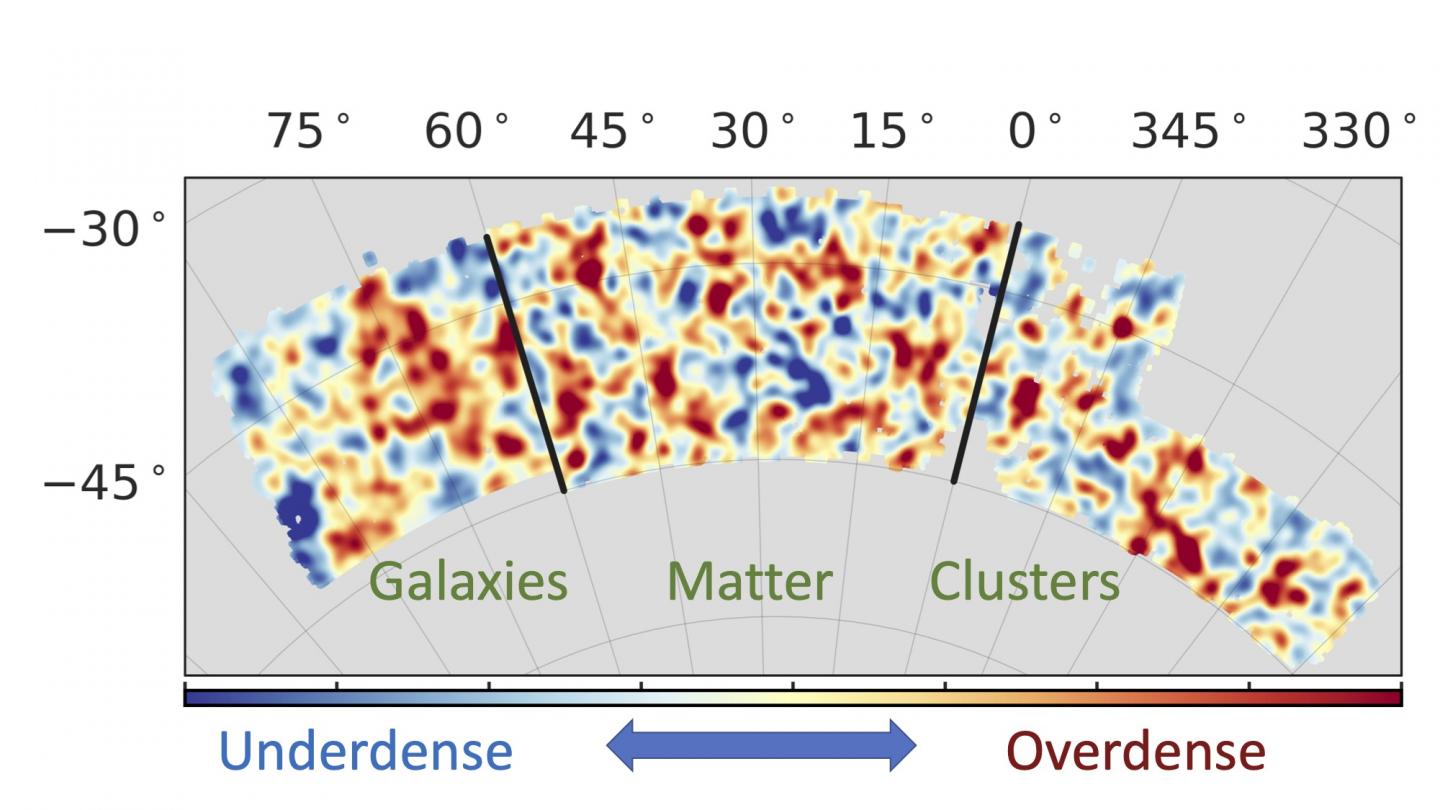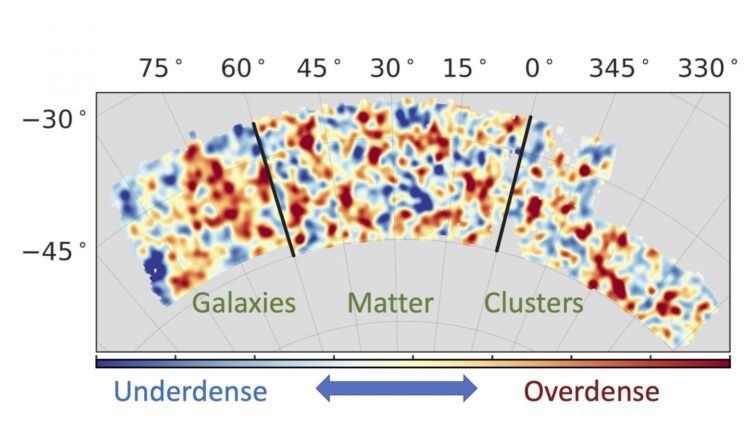For the first time, DES scientists can combine measurements of the distribution of matter, galaxies, and galaxy clusters to advance our understanding of dark energy.

Credit: Chun-Hao To/Stanford University, SLAC National Accelerator Laboratory
The universe is expanding at an ever-increasing rate, and while no one is sure why, researchers with the Dark Energy Survey (DES) at least had a strategy for figuring it out: They would combine measurements of the distribution of matter, galaxies and galaxy clusters to better understand what’s going on.
Reaching that goal turned out to be pretty tricky, but now a team led by researchers at the Department of Energy’s SLAC National Accelerator Laboratory, Stanford University and the University of Arizona have come up with a solution. Their analysis, published April 6 in Physical Review Letters, yields more precise estimates of the average density of matter as well as its propensity to clump together – two key parameters that help physicists probe the nature of dark matter and dark energy, the mysterious substances that make up the vast majority of the universe.
“It is one of the best constraints from one of the best data sets to date,” says Chun-Hao To, a lead author on the new paper and a graduate student at SLAC and Stanford working with Kavli Institute for Particle Astrophysics and Cosmology Director Risa Wechsler.
An early goal
When DES set out in 2013 to map an eighth of the sky, the goal was to gather four kinds of data: the distances to certain types of supernovae, or exploding stars; the distribution of matter in the universe; the distribution of galaxies; and the distribution of galaxy clusters. Each tells researchers something about how the universe has evolved over time.
Ideally, scientists would put all four data sources together to improve their estimates, but there’s a snag: The distributions of matter, galaxies, and galaxy clusters are all closely related. If researchers don’t take these relationships into account, they will end up “double counting,” placing too much weight on some data and not enough on others, To says.
To avoid mishandling all this information, To, University of Arizona astrophysicist Elisabeth Krause and colleagues have developed a new model that could properly account for the connections in the distributions of all three quantities: matter, galaxies, and galaxy clusters. In doing so, they were able to produce the first-ever analysis to properly combine all these disparate data sets in order to learn about dark matter and dark energy.
Improving estimates
Adding that model into the DES analysis has two effects, To says. First, measurements of the distributions of matter, galaxies and galaxy clusters tend to introduce different kinds of errors. Combining all three measurements makes it easier to identify any such errors, making the analysis more robust. Second, the three measurements differ in how sensitive they are to the average density of matter and its clumpiness. As a result, combining all three can improve the precision with which the DES can measure dark matter and dark energy.
In the new paper, To, Krause and colleagues applied their new methods to the first year of DES data and sharpened the precision of previous estimates for matter’s density and clumpiness.
Now that the team can incorporate matter, galaxies and galaxy clusters simultaneously in their analysis, adding in supernova data will be relatively straightforward, since that kind of data is not as closely related with the other three, To says.
“The immediate next step,” he says, “is to apply the machinery to DES Year 3 data, which has three times larger coverage of the sky.” This is not as simple as it sounds: While the basic idea is the same, the new data will require additional efforts to improve the model to keep up with the higher quality of the newer data, To says.
“This analysis is really exciting,” Wechsler said. “I expect it to set a new standard in the way we are able to analyze data and learn about dark energy from large surveys, not only for DES but also looking forward to the incredible data that we will get from the Vera Rubin Observatory’s Legacy Survey of Space and Time in a few years.”
###
The research was a collaborative effort within the Dark Energy Survey and was supported by the National Science Foundation and the Department of Energy’s Office of Science.
SLAC is a vibrant multiprogram laboratory that explores how the universe works at the biggest, smallest and fastest scales and invents powerful tools used by scientists around the globe. With research spanning particle physics, astrophysics and cosmology, materials, chemistry, bio- and energy sciences and scientific computing, we help solve real-world problems and advance the interests of the nation.
SLAC is operated by Stanford University for the U.S. Department of Energy’s Office of Science. The Office of Science is the single largest supporter of basic research in the physical sciences in the United States and is working to address some of the most pressing challenges of our time.
Media Contact
Nathan Collins
[email protected]
Original Source
https:/
Related Journal Article
http://dx.





